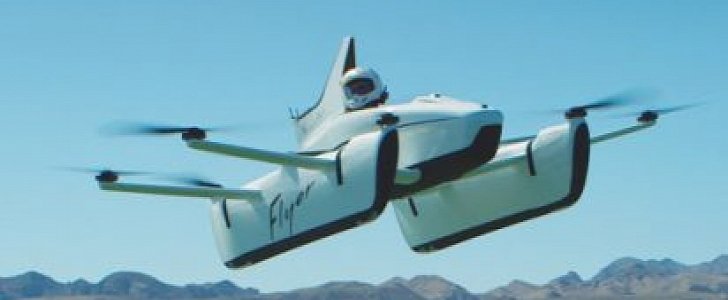The world’s first human drone to be operated by non-pilots has been grounded for good: the Flyer project by Kitty Hawk, arguably one of the eVTOL aircraft closest to achieving man’s dream of flying cars, has been shut down.
Kitty Hawk has been in the business of flying aircraft for almost a decade, and five of those years were spent focusing on Flyer, a light, one person eVTOL that was seen as the future of flying cars.
Introduced in 2018, the Flyer weighed just 250 pounds (113 kg) when empty, qualifying as an ultra-lightweight aircraft for recreational use that could be flown without a license. This meant that anyone could hop on board and go flying after as little as two hours’ worth of training.
The project was a success, Flyer president Alex Roetter and Kitty Hawk CEO Sebastian Thrun said in a blog post last week, with some 111 prototypes developed along the years and 25,000 crewed and uncrewed test flights, some of them with non-pilots that had been trained on the spot. They just couldn’t make it commercially viable.
Consequently, the Flyer project has been grounded and Kitty Hawk’s efforts will be focused from now on the Heavyside electric airplane.
“Since Flyer began, more powerful eVTOL vehicles have been invented, such as our own Heaviside plane, which has a range of 100 miles, speeds of up to 180 mph, and the ability to fly over cities,” the post reads.
“Going forward, we are doubling down on Heaviside as our primary platform. But we would never have gotten here without launching and learning from Flyer, and the amazing team of people who built and operated it,” says the same statement.
The Heaviside, which is shown in the second video at the bottom of the page, is several times quieter than a helicopter and can be flown and landed autonomously. It is also fast and, unlike Flyer, has the advantages of being flown over cities – when development will help it pass FAA certification.
Introduced in 2018, the Flyer weighed just 250 pounds (113 kg) when empty, qualifying as an ultra-lightweight aircraft for recreational use that could be flown without a license. This meant that anyone could hop on board and go flying after as little as two hours’ worth of training.
The project was a success, Flyer president Alex Roetter and Kitty Hawk CEO Sebastian Thrun said in a blog post last week, with some 111 prototypes developed along the years and 25,000 crewed and uncrewed test flights, some of them with non-pilots that had been trained on the spot. They just couldn’t make it commercially viable.
Consequently, the Flyer project has been grounded and Kitty Hawk’s efforts will be focused from now on the Heavyside electric airplane.
“Since Flyer began, more powerful eVTOL vehicles have been invented, such as our own Heaviside plane, which has a range of 100 miles, speeds of up to 180 mph, and the ability to fly over cities,” the post reads.
“Going forward, we are doubling down on Heaviside as our primary platform. But we would never have gotten here without launching and learning from Flyer, and the amazing team of people who built and operated it,” says the same statement.
The Heaviside, which is shown in the second video at the bottom of the page, is several times quieter than a helicopter and can be flown and landed autonomously. It is also fast and, unlike Flyer, has the advantages of being flown over cities – when development will help it pass FAA certification.







